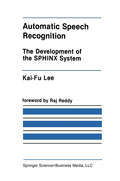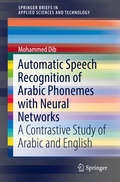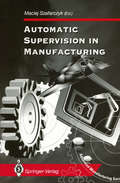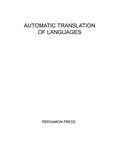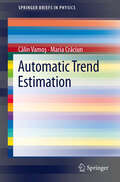- Table View
- List View
Automatic Speech and Speaker Recognition: Large Margin and Kernel Methods
by Joseph Keshet Samy BengioThis book discusses large margin and kernel methods for speech and speaker recognition Speech and Speaker Recognition: Large Margin and Kernel Methods is a collation of research in the recent advances in large margin and kernel methods, as applied to the field of speech and speaker recognition. It presents theoretical and practical foundations of these methods, from support vector machines to large margin methods for structured learning. It also provides examples of large margin based acoustic modelling for continuous speech recognizers, where the grounds for practical large margin sequence learning are set. Large margin methods for discriminative language modelling and text independent speaker verification are also addressed in this book. Key Features: Provides an up-to-date snapshot of the current state of research in this field Covers important aspects of extending the binary support vector machine to speech and speaker recognition applications Discusses large margin and kernel method algorithms for sequence prediction required for acoustic modeling Reviews past and present work on discriminative training of language models, and describes different large margin algorithms for the application of part-of-speech tagging Surveys recent work on the use of kernel approaches to text-independent speaker verification, and introduces the main concepts and algorithms Surveys recent work on kernel approaches to learning a similarity matrix from data This book will be of interest to researchers, practitioners, engineers, and scientists in speech processing and machine learning fields.
Automatic Speech and Speaker Recognition: Advanced Topics (The Springer International Series in Engineering and Computer Science #355)
by Chin-Hui Lee Frank K. Soong Kuldip PaliwalResearch in the field of automatic speech and speaker recognition has made a number of significant advances in the last two decades, influenced by advances in signal processing, algorithms, architectures, and hardware. These advances include: the adoption of a statistical pattern recognition paradigm; the use of the hidden Markov modeling framework to characterize both the spectral and the temporal variations in the speech signal; the use of a large set of speech utterance examples from a large population of speakers to train the hidden Markov models of some fundamental speech units; the organization of speech and language knowledge sources into a structural finite state network; and the use of dynamic, programming based heuristic search methods to find the best word sequence in the lexical network corresponding to the spoken utterance. Automatic Speech and Speaker Recognition: Advanced Topics groups together in a single volume a number of important topics on speech and speaker recognition, topics which are of fundamental importance, but not yet covered in detail in existing textbooks. Although no explicit partition is given, the book is divided into five parts: Chapters 1-2 are devoted to technology overviews; Chapters 3-12 discuss acoustic modeling of fundamental speech units and lexical modeling of words and pronunciations; Chapters 13-15 address the issues related to flexibility and robustness; Chapter 16-18 concern the theoretical and practical issues of search; Chapters 19-20 give two examples of algorithm and implementational aspects for recognition system realization. Audience: A reference book for speech researchers and graduate students interested in pursuing potential research on the topic. May also be used as a text for advanced courses on the subject.
Automatic Speech Recognition: The Development of the SPHINX System (The Springer International Series in Engineering and Computer Science #62)
by Kai-Fu LeeSpeech Recognition has a long history of being one of the difficult problems in Artificial Intelligence and Computer Science. As one goes from problem solving tasks such as puzzles and chess to perceptual tasks such as speech and vision, the problem characteristics change dramatically: knowledge poor to knowledge rich; low data rates to high data rates; slow response time (minutes to hours) to instantaneous response time. These characteristics taken together increase the computational complexity of the problem by several orders of magnitude. Further, speech provides a challenging task domain which embodies many of the requirements of intelligent behavior: operate in real time; exploit vast amounts of knowledge, tolerate errorful, unexpected unknown input; use symbols and abstractions; communicate in natural language and learn from the environment. Voice input to computers offers a number of advantages. It provides a natural, fast, hands free, eyes free, location free input medium. However, there are many as yet unsolved problems that prevent routine use of speech as an input device by non-experts. These include cost, real time response, speaker independence, robustness to variations such as noise, microphone, speech rate and loudness, and the ability to handle non-grammatical speech. Satisfactory solutions to each of these problems can be expected within the next decade. Recognition of unrestricted spontaneous continuous speech appears unsolvable at present. However, by the addition of simple constraints, such as clarification dialog to resolve ambiguity, we believe it will be possible to develop systems capable of accepting very large vocabulary continuous speechdictation.
Automatic Speech Recognition: A Deep Learning Approach (Signals and Communication Technology)
by Dong Yu Li DengThis book provides a comprehensive overview of the recent advancement in the field of automatic speech recognition with a focus on deep learning models including deep neural networks and many of their variants. This is the first automatic speech recognition book dedicated to the deep learning approach. In addition to the rigorous mathematical treatment of the subject, the book also presents insights and theoretical foundation of a series of highly successful deep learning models.
Automatic Speech Recognition and Translation for Low Resource Languages
by L. Ashok Kumar D. Karthika Renuka Bharathi Raja Chakravarthi Thomas MandlAUTOMATIC SPEECH RECOGNITION and TRANSLATION for LOW-RESOURCE LANGUAGES This book is a comprehensive exploration into the cutting-edge research, methodologies, and advancements in addressing the unique challenges associated with ASR and translation for low-resource languages. Automatic Speech Recognition and Translation for Low Resource Languages contains groundbreaking research from experts and researchers sharing innovative solutions that address language challenges in low-resource environments. The book begins by delving into the fundamental concepts of ASR and translation, providing readers with a solid foundation for understanding the subsequent chapters. It then explores the intricacies of low-resource languages, analyzing the factors that contribute to their challenges and the significance of developing tailored solutions to overcome them. The chapters encompass a wide range of topics, ranging from both the theoretical and practical aspects of ASR and translation for low-resource languages. The book discusses data augmentation techniques, transfer learning, and multilingual training approaches that leverage the power of existing linguistic resources to improve accuracy and performance. Additionally, it investigates the possibilities offered by unsupervised and semi-supervised learning, as well as the benefits of active learning and crowdsourcing in enriching the training data. Throughout the book, emphasis is placed on the importance of considering the cultural and linguistic context of low-resource languages, recognizing the unique nuances and intricacies that influence accurate ASR and translation. Furthermore, the book explores the potential impact of these technologies in various domains, such as healthcare, education, and commerce, empowering individuals and communities by breaking down language barriers. Audience The book targets researchers and professionals in the fields of natural language processing, computational linguistics, and speech technology. It will also be of interest to engineers, linguists, and individuals in industries and organizations working on cross-lingual communication, accessibility, and global connectivity.
Automatic Speech Recognition and Translation for Low Resource Languages
by L. Ashok Kumar D. Karthika Renuka Bharathi Raja Chakravarthi Thomas MandlAUTOMATIC SPEECH RECOGNITION and TRANSLATION for LOW-RESOURCE LANGUAGES This book is a comprehensive exploration into the cutting-edge research, methodologies, and advancements in addressing the unique challenges associated with ASR and translation for low-resource languages. Automatic Speech Recognition and Translation for Low Resource Languages contains groundbreaking research from experts and researchers sharing innovative solutions that address language challenges in low-resource environments. The book begins by delving into the fundamental concepts of ASR and translation, providing readers with a solid foundation for understanding the subsequent chapters. It then explores the intricacies of low-resource languages, analyzing the factors that contribute to their challenges and the significance of developing tailored solutions to overcome them. The chapters encompass a wide range of topics, ranging from both the theoretical and practical aspects of ASR and translation for low-resource languages. The book discusses data augmentation techniques, transfer learning, and multilingual training approaches that leverage the power of existing linguistic resources to improve accuracy and performance. Additionally, it investigates the possibilities offered by unsupervised and semi-supervised learning, as well as the benefits of active learning and crowdsourcing in enriching the training data. Throughout the book, emphasis is placed on the importance of considering the cultural and linguistic context of low-resource languages, recognizing the unique nuances and intricacies that influence accurate ASR and translation. Furthermore, the book explores the potential impact of these technologies in various domains, such as healthcare, education, and commerce, empowering individuals and communities by breaking down language barriers. Audience The book targets researchers and professionals in the fields of natural language processing, computational linguistics, and speech technology. It will also be of interest to engineers, linguists, and individuals in industries and organizations working on cross-lingual communication, accessibility, and global connectivity.
Automatic Speech Recognition of Arabic Phonemes with Neural Networks: A Contrastive Study of Arabic and English (SpringerBriefs in Applied Sciences and Technology)
by Mohammed DibThis book presents a contrastive linguistics study of Arabic and English for the dual purposes of improved language teaching and speech processing of Arabic via spectral analysis and neural networks. Contrastive linguistics is a field of linguistics which aims to compare the linguistic systems of two or more languages in order to ease the tasks of teaching, learning, and translation. The main focus of the present study is to treat the Arabic minimal syllable automatically to facilitate automatic speech processing in Arabic. It represents important reading for language learners and for linguists with an interest in Arabic and computational approaches.
Automatic Speech Recognition on Mobile Devices and over Communication Networks (Advances in Computer Vision and Pattern Recognition)
by Zheng-Hua Tan Boerge LindbergThe advances in computing and networking have sparked an enormous interest in deploying automatic speech recognition on mobile devices and over communication networks. This book brings together academic researchers and industrial practitioners to address the issues in this emerging realm and presents the reader with a comprehensive introduction to the subject of speech recognition in devices and networks. It covers network, distributed and embedded speech recognition systems.
Automatic Speech Signal Analysis for Clinical Diagnosis and Assessment of Speech Disorders (SpringerBriefs in Speech Technology)
by Ladan Baghai-Ravary Steve W. BeetAutomatic Speech Signal Analysis for Clinical Diagnosis and Assessment of Speech Disorders provides a survey of methods designed to aid clinicians in the diagnosis and monitoring of speech disorders such as dysarthria and dyspraxia, with an emphasis on the signal processing techniques, statistical validity of the results presented in the literature, and the appropriateness of methods that do not require specialized equipment, rigorously controlled recording procedures or highly skilled personnel to interpret results. Such techniques offer the promise of a simple and cost-effective, yet objective, assessment of a range of medical conditions, which would be of great value to clinicians. The ideal scenario would begin with the collection of examples of the clients’ speech, either over the phone or using portable recording devices operated by non-specialist nursing staff. The recordings could then be analyzed initially to aid diagnosis of conditions, and subsequently to monitor the clients’ progress and response to treatment. The automation of this process would allow more frequent and regular assessments to be performed, as well as providing greater objectivity.
Automatic Speech Translation
by Akira KurematsuAutomatic Speech Translation introduces recent results of Japanese research and development in speech translation and speech recognition. Topics covered include: fundamental concepts of speech recognition; speech pattern representation; phoneme-based HMM phoneme recognition; continuous speech recognition; speaker adaptation; speaker-independent speech recognition; utterance analysis, utterance transfer, utterance generation; contextual processing; speech synthesis and an experimental system of speech translation. This book presents the complicated technological aspects of machine translation and speech recognition, and outlines the future directions of this rapidly developing area of technology.
Automatic Speech Translation
Automatic Speech Translation introduces recent results of Japanese research and development in speech translation and speech recognition. Topics covered include: fundamental concepts of speech recognition; speech pattern representation; phoneme-based HMM phoneme recognition; continuous speech recognition; speaker adaptation; speaker-independent speech recognition; utterance analysis, utterance transfer, utterance generation; contextual processing; speech synthesis and an experimental system of speech translation. This book presents the complicated technological aspects of machine translation and speech recognition, and outlines the future directions of this rapidly developing area of technology.
Automatic Structural Synthesis and Creative Design of Mechanisms (Springer Tracts in Mechanical Engineering)
by Andrés Kecskeméthy Huafeng Ding Wenjian YangThis book provides a comprehensive overview of the current research status and open problems in the field of structural synthesis, based on which a systematic methodology for the structural analysis of planar kinematic chains, structural synthesis of planar kinematic chains, and creative design of mechanisms is presented.The method presented in this book not only promotes the development of theoretical research in the field of mechanical science, and the development of industrial software for the creative design of mechanisms, but also generates novel high-performance mechanisms suitable for industrial application, which can improve the work efficiency and economic benefits. This book offers theoretical guidance for students and researchers engaged in the field of mechanical engineering, especially the creative design of mechanism.
Automatic Supervision in Manufacturing (Advanced Manufacturing)
by Maciej SzafarczykAutomation is a predominant objective in the development of modern and advanced manufacturing production. Automatic Supervision in Manufacturing (ASM) addresses unavoidable disturbances occurring during production. Its application results in the unmanned functioning of manufacturing systems through comprehensive and reliable supervision. Automatic Supervision in Manufacturing is a collection of contributions written by specialists in the field from Europe and the USA. It deals with the concept of automatic supervision, the classification of supervisory systems and their functions. This publication will be of great interest to researchers and engineers in the areas of production and manufacturing.
Automatic Syntactic Analysis Based on Selectional Preferences (Studies in Computational Intelligence #765)
by Alexander Gelbukh Hiram CalvoThis book describes effective methods for automatically analyzing a sentence, based on the syntactic and semantic characteristics of the elements that form it. To tackle ambiguities, the authors use selectional preferences (SP), which measure how well two words fit together semantically in a sentence. Today, many disciplines require automatic text analysis based on the syntactic and semantic characteristics of language and as such several techniques for parsing sentences have been proposed. Which is better? In this book the authors begin with simple heuristics before moving on to more complex methods that identify nouns and verbs and then aggregate modifiers, and lastly discuss methods that can handle complex subordinate and relative clauses. During this process, several ambiguities arise. SP are commonly determined on the basis of the association between a pair of words. However, in many cases, SP depend on more words. For example, something (such as grass) may be edible, depending on who is eating it (a cow?). Moreover, things such as popcorn are usually eaten at the movies, and not in a restaurant. The authors deal with these phenomena from different points of view.
Automatic Test Equipment
by Keith BrindleyAutomatic Test Equipment provides a clear and concise discussion of automatic test equipment. The book is comprised of nine chapters that deal with both concepts and standards. Chapter 1 reviews the term of automatic test equipment, while Chapter 2 covers the types of test equipment. Chapter 3 discusses fixture, and Chapters 4 and 5 talk about the strategies, methods, and processes used by automatic test equipment systems. The book also deals with computer and instrument buses, and then covers general-purpose interface bus. The last two chapters discuss the VMEbus and VXIbus. The text will be of great use to practitioners from different fields who wish to utilize automatic test equipment in their work.
Automatic Text Simplification (Synthesis Lectures on Human Language Technologies)
by Horacio SaggionThanks to the availability of texts on the Web in recent years, increased knowledge and information have been made available to broader audiences. However, the way in which a text is written—its vocabulary, its syntax—can be difficult to read and understand for many people, especially those with poor literacy, cognitive or linguistic impairment, or those with limited knowledge of the language of the text. Texts containing uncommon words or long and complicated sentences can be difficult to read and understand by people as well as difficult to analyze by machines. Automatic text simplification is the process of transforming a text into another text which, ideally conveying the same message, will be easier to read and understand by a broader audience. The process usually involves the replacement of difficult or unknown phrases with simpler equivalents and the transformation of long and syntactically complex sentences into shorter and less complex ones. Automatic text simplification, a research topic which started 20 years ago, now has taken on a central role in natural language processing research not only because of the interesting challenges it posesses but also because of its social implications. This book presents past and current research in text simplification, exploring key issues including automatic readability assessment, lexical simplification, and syntactic simplification. It also provides a detailed account of machine learning techniques currently used in simplification, describes full systems designed for specific languages and target audiences, and offers available resources for research and development together with text simplification evaluation techniques.
Automatic Text Summarization (Iste Ser.)
by Juan-Manuel Torres-MorenoTextual information in the form of digital documents quickly accumulates to create huge amounts of data. The majority of these documents are unstructured: it is unrestricted text and has not been organized into traditional databases. Processing documents is therefore a perfunctory task, mostly due to a lack of standards. It has thus become extremely difficult to implement automatic text analysis tasks. Automatic Text Summarization (ATS), by condensing the text while maintaining relevant information, can help to process this ever-increasing, difficult-to-handle, mass of information. This book examines the motivations and different algorithms for ATS. The author presents the recent state of the art before describing the main problems of ATS, as well as the difficulties and solutions provided by the community. The book provides recent advances in ATS, as well as current applications and trends. The approaches are statistical, linguistic and symbolic. Several examples are also included in order to clarify the theoretical concepts.
Automatic Text Summarization
by Juan-Manuel Torres-MorenoTextual information in the form of digital documents quickly accumulates to create huge amounts of data. The majority of these documents are unstructured: it is unrestricted text and has not been organized into traditional databases. Processing documents is therefore a perfunctory task, mostly due to a lack of standards. It has thus become extremely difficult to implement automatic text analysis tasks. Automatic Text Summarization (ATS), by condensing the text while maintaining relevant information, can help to process this ever-increasing, difficult-to-handle, mass of information. This book examines the motivations and different algorithms for ATS. The author presents the recent state of the art before describing the main problems of ATS, as well as the difficulties and solutions provided by the community. The book provides recent advances in ATS, as well as current applications and trends. The approaches are statistical, linguistic and symbolic. Several examples are also included in order to clarify the theoretical concepts.
Automatic Tools for Designing Office Information Systems: The TODOS Approach (Research Reports Esprit #1)
by Barbara Pernici Colette RollandThe market for information technology products is rapidly changing from a manufactur er-driven market where new products were determined by the evolution of technology, to a user-driven market where users buy only products corresponding exactly to their needs and where competition is very strong. Confronted with this market situation, hardware and software producers are being obliged to adopt new strategies, and to make a large number of products available on the market in response to a variety of different needs. As a result of the multiplicity of choice available, the design of an office system which corresponds precisely to user needs is becoming an increasingly complex task. With exactly this in mind, the Commission, as early as 1985, invited submissions of projects aiming at the development of such adequate tools in its Call for Proposals for the ESPRIT Programme, in order to assist companies in the design of their office systems. This topic was recognised as being of strategic importance, considering the low level of penetration of Information Technology in European enterprises compared to the United States and Japan. Following this strategy, the project TODOS was selected and launched. This project has successfully developed tools and methods for the definition of the functional specifi cation of the office system, as well as the system architecture and user interface -results which can be of great interest for the IT community at large.
Automatic Translation of Languages: Papers Presented at NATO Summer School Held in Venice, July 1962
by Aldo GhizzettiAutomatic Translation of Languages is a collection of papers that discusses the various concerns in automatic language translation systems. The text first covers algebraic linguistics and machine translation, and then proceeds to tackling the main concepts in automatic translation of languages. Next, the selection deals with the equivalence of models of language used in the fields of mechanical translation and information retrieval. The text also discusses computational procedure in linguistic research. The next chapters detail syntax and syntactic integration. The book will be of great use to scientists and professionals who involved in the research and development of computerized language translation systems.
Automatic trend estimation (SpringerBriefs in Physics)
by C˘alin Vamos¸ Maria Cr˘aciunOur book introduces a method to evaluate the accuracy of trend estimation algorithms under conditions similar to those encountered in real time series processing. This method is based on Monte Carlo experiments with artificial time series numerically generated by an original algorithm. The second part of the book contains several automatic algorithms for trend estimation and time series partitioning. The source codes of the computer programs implementing these original automatic algorithms are given in the appendix and will be freely available on the web. The book contains clear statement of the conditions and the approximations under which the algorithms work, as well as the proper interpretation of their results. We illustrate the functioning of the analyzed algorithms by processing time series from astrophysics, finance, biophysics, and paleoclimatology. The numerical experiment method extensively used in our book is already in common use in computational and statistical physics.
Automatic Tuning of Compilers Using Machine Learning (SpringerBriefs in Applied Sciences and Technology)
by Amir H. Ashouri Gianluca Palermo John Cavazos Cristina SilvanoThis book explores break-through approaches to tackling and mitigating the well-known problems of compiler optimization using design space exploration and machine learning techniques. It demonstrates that not all the optimization passes are suitable for use within an optimization sequence and that, in fact, many of the available passes tend to counteract one another. After providing a comprehensive survey of currently available methodologies, including many experimental comparisons with state-of-the-art compiler frameworks, the book describes new approaches to solving the problem of selecting the best compiler optimizations and the phase-ordering problem, allowing readers to overcome the enormous complexity of choosing the right order of optimizations for each code segment in an application. As such, the book offers a valuable resource for a broad readership, including researchers interested in Computer Architecture, Electronic Design Automation and Machine Learning, as well as computer architects and compiler developers.
Automatic Verification of Sequential Infinite-State Processes (Lecture Notes in Computer Science #1354)
by Olaf BurkartA common approach in software engineering is to apply during the design phase a variety of structured techniques like top-down design, decomposition and abstraction, while only subsequently, in the implementation phase, is the design tested to ensure reliability. But this approach neglects that central aspects of software design and program development have a strong formal character which admits tool support for the construction of reliable and correct computer systems based on formal reasoning. This monograph provides much information both for theoreticians interested in algebraic theories, and for software engineers building practically relevant tools. The author presents the theoretical foundations needed for the verification of reactive, sequential infinite-state systems.
Automatic Wealth: The Six Steps to Financial Independence (Agora Series #59)
by Michael Masterson"I have known Michael for over twenty years. He has one of the smartest business minds I know. When he gives me advice, I pay attention, and you should, too. Automatic Wealth is full of wisdom and insight filtered by a master and brought to you in a well-written and delightful style." -John Mauldin, Editor of the bestselling book, Just One Thing: Twelve of the World's Best Investors Reveal the One Strategy You Can't Overlook "I am not usually a fan of this kind of book. One entitled Automatic Wealth made me suspicious. But I am a fan of Michael Masterson, and when I read the book, I was impressed. Masterson manages to go beyond the theory to tell you exactly how real people make real money in the real world. That, I think, is his genius. He's able to open his own eyes and see for himself what actually works. The result is original, clever, and very helpful to anyone who is serious about building wealth." -Bill Bonner, coauthor of Empire of Debt: The Rise of an Epic Financial Crisis "Michael Masterson has been a great friend of mine for over twenty years. I know for a fact that the strategy he teaches is the exact same strategy he has personally used to amass extraordinary wealth and prosperity for himself. He's reduced a normally daunting process down to six simple and unfailing steps YOU can absolutely use to vastly and rapidly increase your financial situation, often times doubling and redoubling your wealth every few years. This book will become your financial bible." -Jay Abraham, author of Getting Everything You Can Out of All You've Got: 21 Ways You Can Out-Think, Out-Perform, and Out-Earn the Competition "Michael Masterson's book is brilliant and concise, packed with breakthrough insights and unique wealth-building tips. Best of all, it's practical because it combines proven investment and financial planning advice with street-smart business and real estate secrets." -Robert Ringer, author of Action!, Looking Out for #1, and To Be or Not to Be Intimidated?
Automatic Wealth: The Six Steps to Financial Independence (Agora Series #50)
by Michael Masterson"I have known Michael for over twenty years. He has one of the smartest business minds I know. When he gives me advice, I pay attention, and you should, too. Automatic Wealth is full of wisdom and insight filtered by a master and brought to you in a well-written and delightful style." -John Mauldin, Editor of the bestselling book, Just One Thing: Twelve of the World's Best Investors Reveal the One Strategy You Can't Overlook "I am not usually a fan of this kind of book. One entitled Automatic Wealth made me suspicious. But I am a fan of Michael Masterson, and when I read the book, I was impressed. Masterson manages to go beyond the theory to tell you exactly how real people make real money in the real world. That, I think, is his genius. He's able to open his own eyes and see for himself what actually works. The result is original, clever, and very helpful to anyone who is serious about building wealth." -Bill Bonner, coauthor of Empire of Debt: The Rise of an Epic Financial Crisis "Michael Masterson has been a great friend of mine for over twenty years. I know for a fact that the strategy he teaches is the exact same strategy he has personally used to amass extraordinary wealth and prosperity for himself. He's reduced a normally daunting process down to six simple and unfailing steps YOU can absolutely use to vastly and rapidly increase your financial situation, often times doubling and redoubling your wealth every few years. This book will become your financial bible." -Jay Abraham, author of Getting Everything You Can Out of All You've Got: 21 Ways You Can Out-Think, Out-Perform, and Out-Earn the Competition "Michael Masterson's book is brilliant and concise, packed with breakthrough insights and unique wealth-building tips. Best of all, it's practical because it combines proven investment and financial planning advice with street-smart business and real estate secrets." -Robert Ringer, author of Action!, Looking Out for #1, and To Be or Not to Be Intimidated?


